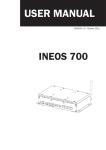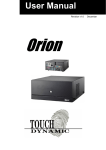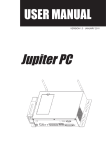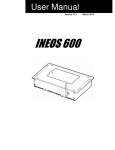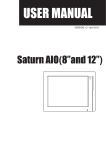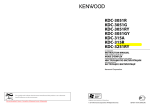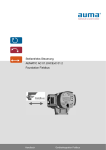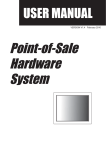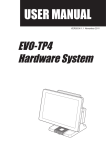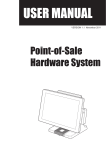Download POS 345 Series User`s Manual
Transcript
User Manual Version V1.0 October 2009 Point-of-Sale Hardware System Copyright 2009 All Rights Reserved Manual Version 1.0 Part Number: 3LMPP3450110 The information contained in this document is subject to change without notice. We make no warranty of any kind with regard to this material, including, but not limited to, the implied warranties of merchantability and fitness for a particular purpose. We shall not be liable for errors contained herein or for incidental or consequential damages in connection with the furnishing, performance, or use of this material. This document contains proprietary information that is protected by copyright. All rights are reserved. No part of this document may be photocopied, reproduced or translated to another language without the prior written consent of the manufacturer. TRADEMARK Intel®, Pentium® and MMX are registered trademarks of Intel® Corporation. Microsoft® and Windows® are registered trademarks of Microsoft Corporation. Other trademarks mentioned herein are the property of their respective owners. i Safety IMPORTANT SAFETY INSTRUCTIONS 1. 2. 3. 4. 5. 6. 7. 8. 9. To disconnect the machine from the electrical power supply, turn off the power switch and remove the power cord plug from the wall socket. The wall socket must be easily accessible and in close proximity to the machine. Read these instructions carefully. Save these instructions for future reference. Follow all warnings and instructions marked on the product. Do not use this product near water. Do not place this product on an unstable cart, stand, or table. The product may fall, causing serious damage to the product. Slots and openings in the cabinet and the back or bottom are provided for ventilation to ensure reliable operation of the product and to protect it from overheating. These openings must not be blocked or covered. The openings should never be blocked by placing the product on a bed, sofa, rug, or other similar surface. This product should never be placed near or over a radiator or heat register or in a built-in installation unless proper ventilation is provided. This product should be operated from the type of power indicated on the marking label. If you are not sure of the type of power available, consult your dealer or local power company. Do not allow anything to rest on the power cord. Do not locate this product where persons will walk on the cord. Never push objects of any kind into this product through cabinet slots as they may touch dangerous voltage points or short out parts that could result in a fire or electric shock. Never spill liquid of any kind on the product. CE MARK This device complies with the requirements of the EEC directive 2004/108/EC with regard to “Electromagnetic compatibility” and 2006/95/EC “Low Voltage Directive”. FCC This device complies with part 15 of the FCC rules. Operation is subject to the following two conditions: (1) This device may not cause harmful interference. (2) This device must accept any interference received, including interference that may cause undesired operation. ii CAUTION ON LITHIUM BATTERIES There is a danger of explosion if the battery is replaced incorrectly. Replace only with the same or equivalent type recommended by the manufacturer. Discard used batteries according to the manufacturer’s instructions. LEGISLATION AND WEEE SYMBOL 2002/96/EC Waste Electrical and Electronic Equipment Directive on the treatment, collection, recycling and disposal of electric and electronic devices and their components. The crossed dustbin symbol on the device means that it should not be disposed of with other household wastes at the end of its working life. Instead, the device should be taken to the waste collection centers for activation of the treatment, collection, recycling and disposal procedure. To prevent possible harm to the environment or human health from uncontrolled waste disposal, please separate this from other types of wastes and recycle it responsibly to promote the sustainable reuse of material resources. Household users should contact either the retailer where they purchased this product, or their local government office, for details of where and how they can take this item for environmentally safe recycling. Business users should contact their supplier and check the terms and conditions of the purchase contract. This product should not be mixed with other commercial wastes for disposal. iii Revision History Changes to the original user manual are listed below: Version Date 1.0 Oct. 2009 Description Initial release iv Table of Contents 1 Package Checklist ................................... 1 1-1 Standard items...........................................................1 1-2 Optional items............................................................2 2 System View............................................. 3 3 System Assembly & Disassembly ......... 6 3-1 Replace the HDD.......................................................6 3-2 Replace the Motherboard ..........................................7 3-3 Replace the Inverter Board & Touch Board .............10 4 Peripheral Installation ........................... 13 4-1 MSR installation.......................................................13 4-2 2-in-1 MSR + iButton Installation .............................14 4-3 2-in-1 MSR + Fingerprint Installation .......................15 4-4 Install a Cash Drawer ..............................................16 4-5 VFD Installation .......................................................18 5 Specification .......................................... 19 6 Jumper Settings .................................... 21 6-1 C36B V0.9 Motherboard Layout ..............................21 6-2 Connectors Description ...........................................22 6-3 Jumper Settings.......................................................23 7 BIOS Settings......................................... 27 Appendix ................................................... 29 v 1 Package Checklist 1-1 Standard items a. d. b. e. c. f. a. b. c. d. e. f. System driver bank User Manual power adapter power cord RJ45 to DB9 cable (x2) 1 1-2 Optional items a. c. b. d. a. b. c. d. 2 MSR 2-in-1 MSR + Fingerprint 2-in-1 MSR + iButton VFD Module (VFD board + metal bracket) 2 System View Front View Rear View 2 4 1 5 6 3 No. Description 1 Touch Screen 2 MSR/2-in-1 MSR (Option) 3 Stand 4 VFD (Option) 5 Speakers (Option) 6 HDD Cover 7 Cables outlet 7 3 Front View_2 Side View 4 2 8 11 6 9 10 Bottom View 12 4 No. Description 8 Ventilation 9 PS/2 10 Power Button 11 Hinge Cover 12 System Box (Inside with Motherboard) Rear I/O View 1 2 3 No. Description 1 Cash Drawer Port 2 USB (x4) 3 LAN (10/100/1000) 4 Serial Port (x4) 5 2nd VGA 6 DC Jack 7 Power Button 4 5 6 7 5 3 System Assembly & Disassembly 3-1 Replace the HDD 6 a. b. Unfasten the screws (x1) to remove the HDD cover. Disconnect the HDD Cable and take out the HDD with HDD metal bracket. c. d. Unfasten the screws (x4) at both sides of HDD metal bracket. Slide out the HDD from the HDD metal bracket and replace the HDD. 3-2 Replace the Motherboard To replace the motherboard, please follow the below steps: (1) Disconnect the HDD cable from the motherboard (Chapter 3-1, step a,b) (2) Open the system box to access the motherboard (See below) a. b. Unfasten the screws (x8) to remove the 2 pieces of plastic covers. Unfasten the screws (x4) that fix the metal cover of system box. c. d. Gently flip down the system box and disconnect the LCD cable (x1). Remove the screws (x5) fastening the metal cover and the motherboard tray. 7 e. Disconnect all the cables. Note: please use a tool to press into the hole as dotted-line circle shows in the right picture to release the HDD connector lock to pull out the HDD cable easily. f. 8 Separate the metal cover from the motherboard tray. g. h. Remove the screws (x5) fixing the motherboard on the motherboard tray. Remove the screws (x6) to separate the motherboard with I/O panel from the motherboard tray. i. j. Slide out the motherboard with metal I/O bracket. Remove the hex screws (x2) to separate the metal I/O bracket from the motherboard. 9 3-3 Replace the Inverter Board & Touch Board The inverter board and touch board are installed inside of the LCD module. You need to follow the steps below first to access them: (1) Disconnect the LCD cable from the motherboard (Chapter 3-2, step a, b, c) (2) Separate the LCD module from the stand and open the LCD rear cover (See below). LCD Module Stand 10 a. Take out the hinge cover at both sides. b. c. Unfasten the screws (x6) on both sides. Separate the LCD module from the stand. d. Unfasten the screws (x2) to remove the MSR dummy cover or MSR/2-in-1 MSR module. VFD Cover LCD Rear Cover e. Unfasten the screws (x5) to remove the LCD rear cover with VFD cover from the LCD bracket. 11 3-3-1 Replace the Inverter Board a. b. c. 3-3-2 Replace the Touch Board a. b. c. 12 The location of Inverter board on the LCD sheet metal bracket. Unfasten the screws (x2). Disconnect the cables (x3). The location of touch board on the LCD sheet metal bracket. Unfasten the screws (x2). Disconnect the cables (x2). 4 Peripheral Installation 4-1 MSR installation Please remove the MSR dummy cover first (Chapter 3-3, step d) a. b. Fasten the grounding cable (x1) and connect the MSR cable (x1). Slide the MSR module into the right position of the system. c. Fasten the screws (x2) to fix the MSR module to the system. 13 4-2 2-in-1 MSR + iButton Installation Please remove the MSR dummy cover first (Chapter 3-3, step d) a. b. 14 Connect the connector (x1) and slide the MSR + iButton module into the right position of the system. Fasten the screws (x2) of the MSR rear cover to fix the 2-in-1 MSR + iButton module to the system. 4-3 2-in-1 MSR + Fingerprint Installation Please remove the MSR dummy cover first (Chapter 3-3, step d) a. Fasten the grounding cable (x2) b. Connect the MSR cable (x1) and Fingerprint cable (x1) c. Slide the 2-in-1MSR + Fingerprint module into the right position of the system. d. Fasten the screws (x2) of the rear cover to fix the 2-in-1 MSR + iButton module into the system. 15 4-4 Install a Cash Drawer You can install a cash drawer through the cash drawer port. Please verify the pin assignment before installation. Cash Drawer Pin Assignment 6 1 Pin Signal 1 GND 2 DOUT bit0 3 DIN bit0 4 12V / 19V 5 DOUT bit1 6 GND Cash Drawer Controller Register The Cash Drawer Controller use one I/O addresses to control the Cash Drawer. Register Location: 48Ch Attribute: Read / Write Size: 8bit BIT Attribute 7 X 6 5 BIT7 BIT6 Reserved 4 X X 3 2 1 BIT5 BIT4 Read Reserved BIT3 BIT2 Write BIT1 BIT0 Reserved 0 X X Reserved Cash Drawer “DOUT bit0” pin output control Cash Drawer “DOUT bit1” pin output control Reserved Cash Drawer “DIN bit0” pin input status Reserved 16 Bit 7: Reserved Bit 6: Cash Drawer “DIN bit0” pin input status. = 1: the Cash Drawer closed or no Cash Drawer = 0: the Cash Drawer opened Bit 5: Reserved Bit 4: Reserved Bit 3: Cash Drawer “DOUT bit1” pin output control. = 1: Opening the Cash Drawer = 0: Allow close the Cash Drawer Bit 2: Cash Drawer “DOUT bit0” pin output control. = 1: Opening the Cash Drawer = 0: Allow close the Cash Drawer Bit 1: Reserved Bit 0: Reserved Note: Please follow the Cash Drawer control signal design to control the Cash Drawer. Cash Drawer Control Command Example Use Debug.EXE program under DOS or Windows98 Command Cash Drawer O 48C 04 Opening O 48C 00 Allow to close Set the I/O address 48Ch bit2 =1 for opening Cash Drawer by “DOUT bit0” pin control. Set the I/O address 48Ch bit2 = 0 for allow close Cash Drawer. Command Cash Drawer I 48C Check status The I/O address 48Ch bit6 =1 mean the Cash Drawer is opened or not exist. The I/O address 48Ch bit6 =0 mean the Cash Drawer is closed. 17 4-5 VFD Installation To install the VFD module, you need to follow the steps below. (1) Disconnect the LCD cable from the motherboard (Chapter 3-2, step a,b,c). (2) Separate the LCD module from the stand and open it (Chapter 3-3) (3) After open the LCD rear cover, you will access the VFD installation bracket, please see detail installation procedure as follows: a c b a. Fasten the screws (x4) to fix the VFD board onto the VFD metal bracket. b. Slide the VFD board with VFD metal bracket into the right position of the LCD metal bracket. c. Fasten the screws (x2) at both sides to fix the VFD board with VFD metal bracket to the LCD metal bracket. 18 5 Specification Model Name POS 345 Motherboard C36 CPU Support Chipset Intel Atom N270 processors 1.6G L2 512K FSB 533MHz Intel 945GSE Express chipset + ICH7M System Memory 1 x DDR2 SO-DIMM up to 2GB Graphic Memory Intel GMA 950 share system memory up to 224MB LCD Touch Panel LCD Size 15” TFT LCD Brightness 250nits Maximal Resolution 1024 x 768 Touch Screen Type Resistive Tilt Angle 0° ~ 70° Storage HDD One 2.5" SATA HDD bay Flash Memory Option SATA SSD flash card Expansion PCI-E Socket 1 External I/O Ports USB Serial / COM PS/2 4 ports (V2.0) 4 x RJ-45 COM connectors ( COM1 & COM2 standard RS-232; COM3 & COM4 pin10 with 5V /12V powered by jumper ) 1 LAN (10/100/1000) 1 x RJ45 DC Jack 1(19V-IN) 2nd VGA 1 Cash Drawer Port Support 1 x RJ 11 (12V / 24V) Audio Speaker Option 2 x 2W speakers 19 Power Power Adapter Ext. 65W, 19V/3.4A Control / Indicator Power Button 1 Indicator LED 1 Peripheral MSR 3Tracks MSR (PS/2) 2-in-1 MSR Customer display MSR (PS/2) + Fingerprint (USB) / MSR (PS/2) + I-button (PS/2) 2 x 20 VFD customer display (COM) Environment EMC & Safety Operating Temperature Storage Temperature FCC/CE Class A, LVD o 5 C ~ 35 oC (41oF ~ 95 oF) -20 oC ~ 55 oC (-4 oF ~ 131 oF) Operating Humidity 20% ~ 80% RH non condensing Storage Humidity 20% ~ 85% RH non condensing Dimension (W x D x H) Weight (N.W./G.W.) OS Support LCD 0 degree : 367.94 x 302.21 x 320.83 mm LCD70 degree : 367.94 x 290 x 220.69 mm 6.4kgs / 7.4kgs Windows XP Professional, Windows XP Embedded, Windows CE, Linux * This specification is subject to change without prior notice. 20 6 Jumper Settings 6-1 C36B V0.9 Motherboard Layout 21 6-2 22 Connectors Description Connector Purpose BAT3 CMOS Battery Base (Use CR2023) CN3 Speaker & MIC Connec tor CN4 Power Connector For HDD CN5 USB5 CN7 LAN LED CN8 COM5 for Touch CN9 Card Reader Connector CN12 IrDA Connector CN13 Inverter Connector CN15 Power LED CN16 LCD Interface Connector CN17 Internal DC-JACK connector CN21 Internal Power On Switch Connector CN22 Internal Power On Switch Connector CN23 To LED Sensor Board CN24 PS2 Keyboard DDR2_A1 DDR2 SO-DIMM PWR3 +19V Power Adaptor RJ11_3 Cash Drawer Connector RJ45_4 COM1, COM2, COM3, COM4 RJ45_5 LAN (On Board) FAN_SYS3 System FAN Connector MINI_PCIE3 Mini PCI-E Socket SATA3 SATA Connector SCSI2 SCSI Connector SKT3 SPI ROM SW3 Power On Button USB3 USB1, USB2 USB4 USB3, USB4 VGA3 VGA Port JP3 LCD ID Setting 6-3 6-3-1 Jumper Settings Cash Drawer Power Settings: JP4 Function JP4 (1-2) (3-4) +12V ◎+19V 6-3-2 Power Mode Settings: JP5 Function JP5 (1-2) ◎ATX Power AT Power 6-3-3 CMOS Operation Mode: JP6 Function JP6 (1-2) ◎CMOS Normal CMOS Reset ◎ = Factory default settings 23 6-3-4 System Reset Settings: JP7 Function JP7 (1-2) ◎Normal Reset 6-3-5 COM3 & COM4 Power Settings: JP8 Function JP8 (1-2) (3-4) (5-6) (7-8) (9-10) (11-12) ◎ RI COM3 Pin10 +5V +12V ◎ RI COM4 Pin10 +5V +12V ◎ = 24 Factory default settings 6-3-6 VGA Power Settings: JP9 Function JP9 (1-2) ◎No Power +12V 6-3-7 Boot Display Device Settings: JP3 Function JP3 (1-2) (3-4) Force CRT only ◎Force LCD only ◎ = Factory default settings 25 6-3-8 LCD ID Settings for LVDS Panel: Panel Number Resolution Bits Channel 1 1024 x 768 24 Single 2 1280 x 1024 24 Dual 3 800 x 600 18 Single 4 1024 x 768 18 Single ◎ = Factory default settings Note: OPEN 26 LVDS SHORT JP3 (5-6) (7-8) 7 BIOS Settings BIOS Main Menu When the BIOS Main Menu is displayed, the following items can be selected. Use the arrow keys to select items and the Enter key to accept and enter the sub-menu. Note: The BIOS setup menus shown in this section are for reference only and may not exactly match the items of your BIOS version. Standard CMOS Features Use this menu for basic system configuration. Advanced BIOS Features Use this menu to set the Advanced Features available on the system. Advanced Chipset Features Use this menu to change the values in the chipset registers and optimize the system’s performance. Integrated Peripherals Use this menu to specify your settings for integrated peripherals. 27 Power Management setup Use this menu to specify your settings for power management. PnP/PCI Configurations This entry appears if your system supports Plug and Play and PCI Configuration. PC health status Displays CPU, System Temperature, Fan Speed, and System Voltages Value. Load Optimized Defaults Use this menu to load the BIOS default values, i.e., factory settings for optimal performance system operations. While Award has designed the custom BIOS to maximize performance, the factory has the option to change these defaults to meet their needs. Set Supervisor Password Enables you to change, set, or disable the supervisor or user password. Set Password Change, set, or disable the password. It allows you to limit access to the system and to the setup, or just to the setup. Save & exit setup Save CMOS value changes to CMOS and exits setup. Exit without saving Ignores all CMOS value changes and exits setup. 28 Appendix Drivers Installation: The shipping package includes a Driver CD. You can find every individual driver and utility that enables you to install the drivers in the Driver CD. Please insert the Driver CD into the drive and double click on the “index.htm” to pick up the models. You can refer to the drivers installation guide for each driver in the “Driver/Manual List”. 29



































